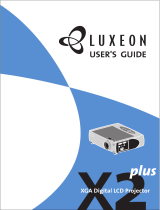E – vi
TABLE OF CONTENTS
1. INTRODUCTION
What's in the Box? ....................................................................................... E-1
Getting to Know Your GT1150 Projector ...................................................... E-2
Attaching the lens hood cap to the lens hood
with the supplied string and rivet............................................... E-4
Carrying the Projector ........................................................................... E-4
Top Features ......................................................................................... E-5
Front Terminal Panel (Right) ................................................................. E-6
Front Terminal Panel (Left).................................................................... E-7
PC Card Viewer .................................................................................... E-7
Remote Control Features ..................................................................... E-8
Remote Control Precautions ....................................................... E-10
Remote Control Battery Installation............................................. E-10
Operating Range for Wireless Remote Control ........................... E-10
Using the Remote Control in Wired Operation ............................ E-11
2. INSTALLATION
Setting Up Your GT1150 Projector ............................................................. E-12
Screen Size and Projection Distance......................................................... E-12
Lens Shift Adjustable Range...................................................................... E-13
Optional Lens Installation........................................................................... E-14
Setting up for Double Stacking in Link Mode ............................................. E-16
Projector Orientation .................................................................................. E-17
3. Basic Operation
Connecting the Power Cable and Turn on the Projector ............................ E-19
About Startup Screen ................................................................................ E-20
Set up the projector.................................................................................... E-21
Other adjustments...................................................................................... E-22
4. CONNECTIONS
When used in standalone operation .......................................................... E-23
Connecting Your VCR Or Laser Disc Player ....................................... E-23
Connecting Your DVD Player with Component Output........................ E-24
Connecting Your PC Or Macintosh Compute...................................... E-25
Connecting an External Monitor ......................................................... E-26
Connecting a PC with DVI output ....................................................... E-26
Connecting to a Single Workstation .................................................... E-27
Ferrite Core Installation ............................................................... E-27
When Used with One Switcher (ISS-6020/ISS-6020G) ............................. E-28
When Used with Two or More Switchers (100 Inputs) ............................... E-29
How to make connections.................................................................. E-29
Set the DIP switch (S8601) of the Switcher as follows ....................... E-30
REMOTE 1 Connector........................................................................ E-31
Operating Multiple Projector with Remote Control ..................................... E-33
Using the PC CONTROL connectors......................................................... E-34
5. OPERATION
General Controls ........................................................................................ E-35
Using the Menus ........................................................................................ E-35
Using the Magnifying Glass Icon ............................................................... E-35
Customizing Basic/Custom Menu .............................................................. E-36
List of Direct Button Combinations............................................................. E-37
Menu Tree .................................................................................................. E-38
Menu Elements .......................................................................................... E-39
Menu Descriptions & Functions ................................................................. E-40
Source Select............................................................................................. E-40
Entry List .................................................................................................... E-40
Picture ........................................................................................................ E-41
Brightness/Contrast/Color/Hue/Sharpness
Volume ....................................................................................................... E-41
Image Options............................................................................................ E-42
Keystone ............................................................................................. E-42
Color Temperature .............................................................................. E-42
Lamp Mode......................................................................................... E-42
Gamma Correction ............................................................................. E-42
Aspect Ratio ....................................................................................... E-42
Noise Reduction ................................................................................. E-42
Color Matrix ........................................................................................ E-43
White Balance..................................................................................... E-43
Switcher Gain ..................................................................................... E-43
Position/Clock ..................................................................................... E-43
Resolution........................................................................................... E-43
Video Filter.......................................................................................... E-44
Overscan ............................................................................................ E-44
Clamp Timing ...................................................................................... E-44
Y/C Delay............................................................................................ E-44
YTR Adjustmen................................................................................... E-44
CTR Adjustment ................................................................................. E-44
HD Delay ............................................................................................ E-44
Factory Default ................................................................................... E-44
Projector Options ....................................................................................... E-44
Timer (On/Off Timer/Sleep Timer) ...................................................... E-44
Menu................................................................................................... E-45
Menu Mode......................................................................................... E-45
Language............................................................................................ E-45
Menu Display Time ............................................................................. E-45
Display Select ..................................................................................... E-46
Date Format........................................................................................ E-46
Date, Time Preset ............................................................................... E-46
Projector Pointer ................................................................................. E-46
Direct Button (Volume Bar and Keystone Bar).................................... E-46
Setup .................................................................................................. E-47
Orientation .......................................................................................... E-47
Background......................................................................................... E-47
PC Card Viewer Options ..................................................................... E-47
Capture Options.................................................................................. E-47
Signal Select....................................................................................... E-47
Signal Select(RGB connector)........................................................... E-48
Auto Adjust (RGB only)....................................................................... E-48
Auto Start............................................................................................ E-48
Power Management ............................................................................ E-48
Power Off Confirmation ...................................................................... E-48
Keystone Save .................................................................................... E-48
Fan High Speed Mode ........................................................................ E-48
Built-in Speaker .................................................................................. E-48
Clear Lamp Hour Meter ...................................................................... E-48
Clear Filter Usage............................................................................... E-48
Remote Sensor................................................................................... E-49
S-Video Mode Select .......................................................................... E-49
Communication Speed ....................................................................... E-49
Projector ID......................................................................................... E-49
Default Source Select ......................................................................... E-49
Link Mode ........................................................................................... E-49
Switcher Control ................................................................................. E-49
Tools........................................................................................................... E-50
Capture ............................................................................................... E-50
PC Card Files ..................................................................................... E-50
Changing Background Logo ............................................................... E-50
Help............................................................................................................ E-51
Contents ............................................................................................. E-51
Information.......................................................................................... E-51
Test Pattern ................................................................................................ E-51
Using the PC Card Viewer Function .......................................................... E-52
Features.............................................................................................. E-52
Inserting and Ejecting a PC Card ....................................................... E-52
Installing the PC Card Viewer Software .............................................. E-53
Starting Up the PC Card Viewer Software on your PC
(PC Card Viewer Utility 10) ................................................................. E-53
Operating the PC Card Viewer Function from the Projector
(playback) ........................................................................................... E-54
Capturing Images Displayed on the Projector .................................... E-56
Viewing Digital Images ....................................................................... E-56
Uninstalling the PC Card Viewer Software ......................................... E-57
6. MAINTENANCE
Replacing the Lamp ................................................................................... E-58
Cleaning or Replacing the Filter................................................................. E-59
Remplacement de la lampe ....................................................................... E-60
Nettoyage ou remplacement du filtre ......................................................... E-61
7. TROUBLESHOOTING
Power / Status Light Messages.................................................................. E-62
Lamp Light Messages ................................................................................ E-62
Common Problems & Solutions ................................................................. E-62
8. SPECIFICATIONS
Optical/Electrical ........................................................................................ E-64
Mechanical ................................................................................................. E-65
Cabinet Dimensions ................................................................................... E-66
Optional Accessories ................................................................................. E-66
D-Sub Pin Assignments ............................................................................. E-67
List of Menu Items Available in Link Mode ................................................. E-68
Timing Chart .............................................................................................. E-69
PC Control Codes ...................................................................................... E-70
Cable Connection ...................................................................................... E-70
Gravity Stack .............................................................................................. E-70





















